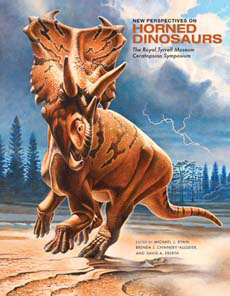Book Review – “New Perspectives on Horned Dinosaurs”
“New Perspectives”, or to give the book its full title – “New Perspectives on Horned Dinosaurs – The Royal Tyrrell Museum Ceratopsian Symposium” is a comprehensive review of virtually all the recently published papers and journal articles on the ceratopsians. It is everything and anything to do with that great family of ornithischian dinosaurs, the horned dinos, from Psittacosaurus to the enormous Triceratops.
Horned Dinosaurs
Over the last three years or so, there have been a number of spectacular new discoveries and a lot of exciting research carried out on the ceratopsians and this volume, sets out to update readers on the latest interpretation of their fossil record. The book is split into thirty-six chapters and it is edited by Dr Michael J. Ryan of the Cleveland Museum of Natural History, Dr Brenda J. Chinnery-Allgeier of the University of Texas and Dr David Eberth of the Royal Tyrrell Museum (Alberta, Canada).
The list of contributors reads like a “who’s who” of modern palaeontology with contributions from the likes of esteemed scientists such as Phil Currie, Peter Dodson, Scott Sampson and Peter Larson. More than five hundred pages dedicated to all things ceratopsian, including descriptions of ten new types, which have recently been discovered.
Front Cover of “New Perspectives”

Picture credit: Donna Sloan
The book can be further divided into five distinct sections. Part one sets the scene and provides an overview of the research carried out on ceratopsids since the 1970s. Part two, updates the reader on the latest research, highlights new discoveries and introduces the recently discovered new taxa. The third part of the book, describes the latest research on ceratopsian behaviour, anatomy, ontogeny and functional biology.
“Horned Dinosaurs in Time and Space”
The penultimate part of the book, entitled “Horned Dinosaurs in Time and Space”, sets out to establish how these dinosaurs became so diverse and radiated out into a myriad of different environments and ecosystems. This section also provides some remarkable insights into ceratopsid trace fossils and bone beds.
The final part of the book provides a history of horned dinosaur fossil collections, and this section works well with the excellent CD-rom that accompanies the volume. The CD-rom lists ceratopsian discoveries and focuses on the work on ceratopsids in Canada.
The book is very technical and not really suitable for the casual reader and there are very few colour plates (hence the CD-rom), however, it is a “must have” for any budding undergraduate studying related Earth Sciences and for the enthusiastic amateur.
For models and replicas of horned dinosaurs, take a look at the Beasts of the Mesozoic ceratopsian figures: Beasts of the Mesozoic Ceratopsian Figures.






Leave A Comment